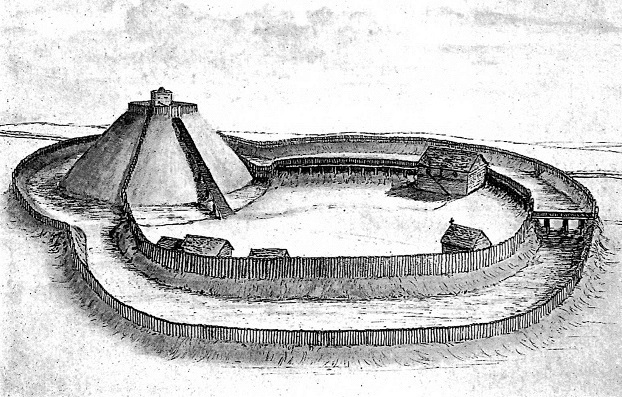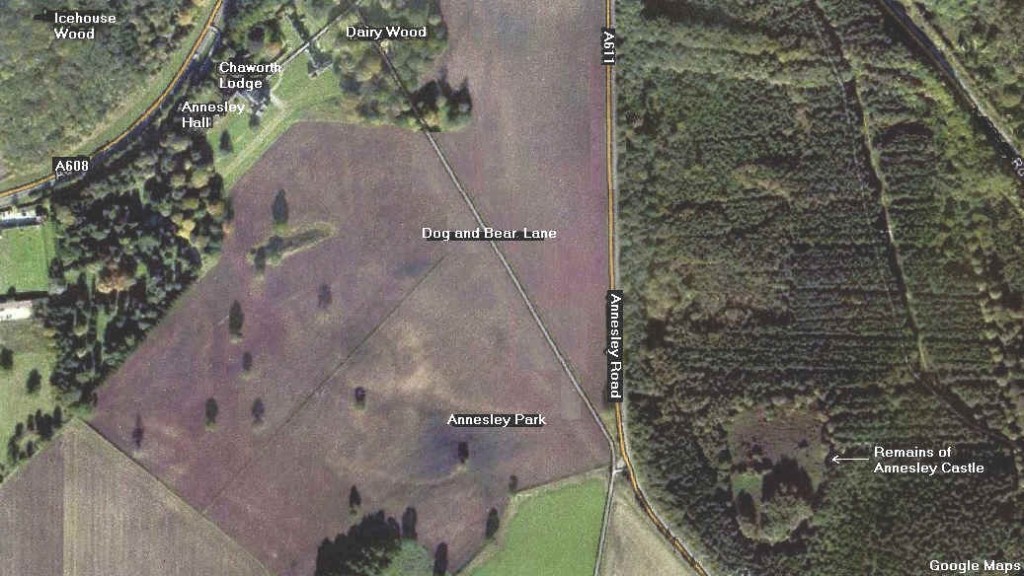Annesley Castle
Annesley Castle, also recorded in historical documents as Anelegh, is a scheduled monument situated nine miles north of Nottingham, in the district of Ashfield. It was a motte and bailey castle, which meant that it was constructed using the oldest methods of fortification, the earthwork, and in all save a few rare instances was without any stone buildings, being a simple but very effective fortress of earthwork and timber alone. This type of fortified castle was introduced into England by the Normans. While varying in detail, the vast majority of these castles conform to a basic and distinctive plan. The most prominent and important feature was a large mound or motte, flattened at the top. Where possible this mound was wholly or partially formed out of a natural hillock or outcrop of rock, but in many cases it was raised by an enormous amount of spade work. At the top of the mound there was usually a wooden tower, the strongpoint and vantage point of the castle, but also designed as the residence of the lord. This strongpoint was further defended by an earthen rampart around its flat summit, and by a deep ditch around its base – the soil from the ditch being used for the raising of the mound and also for the construction of the counterscarp or earthen rampart on the outer circumference of the ditch itself. At the foot of the mound, but separated from it by its ditch, lay the bailey, a simple enclosure marked out and defended by its own earthen rampart and deep ditch with counterscarp. This ditch ran into the ditch of the mound so that the plan is like a figure-of eight, one segment enlarged to form the bailey. The defences of this stronghold were completed by timber stockades, and within these were buildings, also of timber, necessary to make the castle habitable. A stockade of timber posts, bound together, crowned the ramparts around the bailey and was continued up the sides of the mound to join the similar stockade encircling its summit. The outer fringe of the castle, the counterscarp on the outside of the ditches of both mound and bailey, often had its own additional defence of stakes or, perhaps a bramble hedge, while the ditches themselves were where possible, filled with water. Within the bailey were placed the buildings necessary to the castle in its role as fortress, residence, and often the administrative centre of a district – a hall for meals, which was also the centre of social life and often the only accommodation for the lord’s retainers and garrison, a chapel, stables, storehouses and barns, and perhaps a kitchen. Entrance to the castle was gained by a wooden bridge, possibly some form of drawbridge, over the ditch of the bailey, and by a gateway in the stockade, made as strong as possible and often further defended by wooden towers. Communication between the mound, surrounded by its own ditch, and the bailey, was provided generally by a sloping bridge carried on piles, which again at some point could be raised or blocked in case of attack. In siege warfare, if the attackers succeeded in taking the bailey, the defenders would withdraw to the mound and continue their resistance there.
Fragments of bank and ditch across the bailey may indicate that Annesley was divided into two courts, and like most it was made of timber. The structure of the motte has largely survived, along with banks and ditches, and there is the buried remains of buildings and ancillary features. It is not known when the castle was built, however there is a reference to the construction of a house in Sherwood Forest by Regnald de Annesley in 1220; this may refer to the Norman hall half a mile north-west of the castle which was incorporated into the present Annesley Hall, where Robin’s boots were reputedly kept. To the north of the castle is the village of Annesley, which is in the area of a range of sandstone hills called Robin Hood’s Hills. At the easterly end of the range near Hollinwell Golf Club, there is a large flat rock amongst the outcrops known as Robin Hood’s Seat; tradition has it that Robin used to sit there and survey the main road below, looking for wealthy travellers to rob. At the western end of the range is Robin Hood’s Cave, with its obscure opening, which may have been filled in for safety reasons. Its location is difficult to find.
Artist’s reconstruction of a motte-and-bailey-castle, English Medieval Castles, R. Allen Brown, 1954.
John Bellamy (Robin Hood an historical enquiry, 1985, pp. 79-80) thought that Annesley made a good fit with the description of the castle mentioned in stanza 309 of the Gest:
| Then was there a fayre castell |
| A lytell within the wode |
| Double dyched it was about |
| And walled, by the rode |
| . |
This ‘fayre castell’ apparently in Sherwood Forest, is the home of Sir Richard at the Lee*, one of the main characters in the Gest who gives shelter to Robin and his men, but whether this suggests any connection with Annesley Castle is impossible to say. The Castle belonged to Sir John Annesley who also held land in Arksey: Cal. Misc. Inq., iii, no. 242. In 1331 he was accused of having, as verderer of Sherwood, maintained ‘malefactors of the forest’ and was removed from office; Cal. Close Rolls, 1330-3, p. 256.
* Sir Richard at the Lee’s home is called ‘Verysdale’ in some versions of the Gest. In Ritson’s edition of 1820 it appears as ‘Uterysdale’, but in the edition of 1832 it appears as ‘Wierysdale’. Dobson and Taylor (Rymes of Robyn Hood, 1976, p. 88, n. 2) thought that Verysdale was ‘probably a reference to Wyresdale in northern Lancs’. Holt (Robin Hood, 1982, p. 96, 14) thought that the hamlet of Lee in Wyresdale was ‘The most likely legendary home of the knight whom Robin befriended’. On the other hand, John Bellamy thought that Verysdale could be connected to ‘the valley of the River Erewash lying between Nottinghamshire and Derbyshire. In the early fourteenth century this river was known as the Yrewys or Irewys and its valley Irewysdale’. Bellamy saw the possibility that Irewysdale might easily be corrupted into ‘Iverysdale’, and he points out that ‘The River Erewash rises on the eastern edge of Sherwood forest in an area where Robin Hood place names are plentiful’. He further adds that the river runs only two and a half miles from Annesley Castle (Robin Hood an historical enquiry, 1985, pp. 79-80). Richard Firth Green notes Annesley Castle, and he adds: ‘but he [Bellamy] does not note the linguistic similarity: if Yrewis-dale might be orally corrupted to Verysdale, it is hardly a much greater stretch from the rather odd-looking ‘atte Lee’ to Annesley’ (Robin Hood: Medieval and Post-Medieval, Helen Phillips, 2005, ‘The hermit and the outlaw: new evidence for Robin Hood’s death?’, Richard Firth Green, p. 59, n. 20). I tend to agree with Dobson and Taylor who point out: ‘There is also the problem of the identity of Sir Richard and the unnamed knight of the first section. One commentator has suggested that the two knights are not the same person and that ‘for the sake of unity the compiler identified Sir Richard with the unnamed knight of the first section’ (Rymes of Robyn Hood, 1976, p. 77).
This page contains information found in English Medieval Castles, R, Allen Brown, 1954, pp. 22-27; English Heritage; Robin Hood an Historical Inquiry, John Bellamy, 1985, pp. 79-80, and note no. 19, p. 106.

